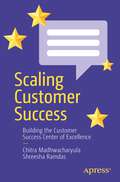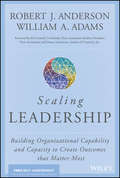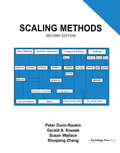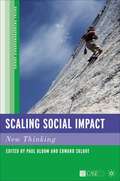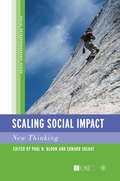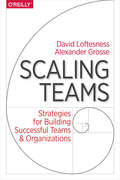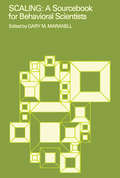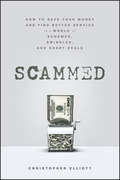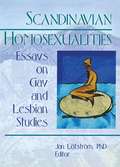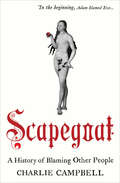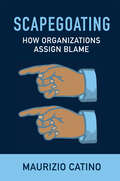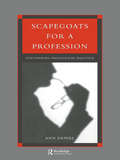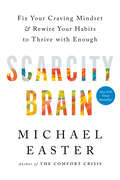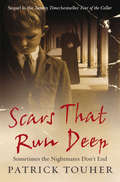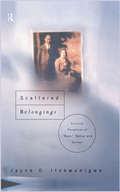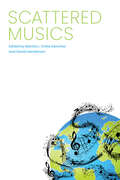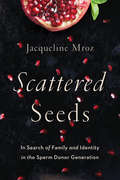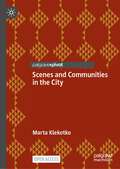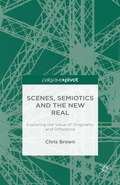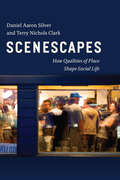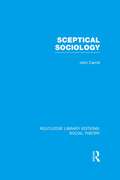- Table View
- List View
Scaling Customer Success: Building the Customer Success Center of Excellence
by Chitra Madhwacharyula Shreesha RamdasCustomer Success is a relatively a new discipline that focuses on maximizing customer business value and outcomes realization. Practitioners focus on customer adoption, customer experience and then positive correlation, organic growth and retention is achieved. This book will provide a practical guide for operationalizing the Customer Success function and methodologies. As we now step into the next phase of Customer Success, a phase of growth and standardization, it becomes important to start thinking about how to effectively scale this extremely important function. You'll see how to go from just offering a taste of Customer Success experience to your top customers, to offering it to all your customers, irrespective of their tier, spending, and current growth potential. As you expand the scope of Customer Success across all your customers, it becomes very important to understand how to operationalize Customer Success, how to convert the philosophies and ideas and best practices to usable operational models, and how to build a Customer Success Center of Excellence (CoE) focused on standardizing, scaling and expanding Customer Success practices and methodologies to optimize customer and company success and ROI. Scaling Customer Success will show you what kind of operational processes and workflows need to be put in place based on the stage of your company, products, customer engagement model and desired outcomes, what metrics are important to measure and how to capture those metrics. You'll also study what kinds of workflows to establish, how to effectively map and analyze results and most importantly, how to do Customer Success at scale effectively.What You'll Learn• Understand what a Customer Success Center of Excellence is• Establish a blueprint for how to scale and automate a Customer Success practice• Review information on key Customer Success metrics and workflowsWho This Book Is ForCompany leaders and customer success managers
Scaling Leadership: Building Organizational Capability and Capacity to Create Outcomes that Matter Most
by Robert J. Anderson Ed Catmull William A. AdamsTransform Your Organization by Scaling Leadership How do senior leaders, in their own words, describe the most effective leaders—the ones that get results, grow the business, enhance the culture and leave in their wake a trail of other really effective leaders? Conversely, how do senior leaders describe the kind of leader that undercuts the organization’s capacity and capability to create its future? This book, based on groundbreaking research, shows how senior leaders describe and develop leadership that works, that does not, that scales, and that limits scale. Is your leadership built for scale as you advance in today’s volatile, uncertain, dynamic, and disruptive business environment? This context puts a premium on a very particular kind of leadership—High-Creative leadership capable of rapidly growing the organization while simultaneously transforming it into more agile, innovative, adaptive and engaging workplace. The research presented in this book suggests that senior leaders can describe the High-Creative leadership with surprising clarity. They also describe with equal precision the High-Reactive leadership that cancels itself out and seriously limits scale. Which type of leader are you? You scale your leadership by increasing the multiple on your leadership in three ways. First, by developing the strengths that differentiate the most effective leaders from the strengths deployed by the most Reactive and ineffective leaders. And second, by increasing your leadership ratio—the ratio of most the effective strengths to the most damaging liabilities. Third, by developing High-Creative leaders all around you. Scaling Leadership provides a proven framework for magnifying agile and scalable leadership in your organization. Scalable leadership drives forward-momentum by multiplying high-achieving leaders at scale so that growth, productivity and innovation increase exponentially. Creative leaders multiply their strengths beyond technical competence by leading in deep relationship, with radical humanity, passion and integrity. Drawing upon decades of solid research and experience enhancing individual capability and collective leadership effectiveness with Fortune 500 companies and government agencies, the authors provide an innovative and efficient framework to help you: Take stock of your own personal balance of leadership strengths and weaknesses Scale your leadership in deep relationship and high integrity Proliferate high-achievers throughout your organization’s leadership system Identify ineffective leadership and course-correct quickly Transform your organization by transforming leadership Scaling Leadership is an invaluable tool for executives, managers, and leaders in business, academia, nonprofit organizations, and more. This innovative resource provides effective techniques, real-world examples, and expert guidance for organizations seeking to improve performance, align and execute strategies, and transform their business with scalable leadership capability.
Scaling Methods
by Peter Dunn-Rankin Gerald A. Knezek Susan R. Wallace Shuqiang ZhangScaling Methods is written for professionals in the behavioral sciences who analyze data that results from subjective responses. Other books on scaling attitudes or measuring perceptions focus on the psychometrician's view of measurement. This book focuses on the users' view by concentrating on effective ways to analyze data rather than the mathematical details of how each program works. The methods included handle the majority of data analysis problems encountered and are accompanied by a software solution. Each chapter features the theory surrounding that methodology, an example, a real-world application, and a computer solution.This book introduces the major uni- and multi-dimensional scaling method techniques most common in educational, social, and psychological research. Using four primary methods of data collection--ordering, categorical rating, free clustering, and similarity judgments--Scaling Methods, Second Edition explains how such data can be represented in ways that illustrate relationships among the data and help reveal underlying dimensional structures. Each method serves as an independent unit so readers can pick and choose from a variety of easy-to-use procedures and more advanced techniques. The new edition features a new chapter on order analysis and downloadable resources that provide stand-alone, as well as SAS supported demonstrations of multi-dimensional scaling techniques, plus programs to get raw data into matrix form. The text is written for researchers, practitioners, and advanced students in education and the social and behavioral sciences interested in analyzing data resulting from subjective responses, especially in the measurement of attitudes. Each chapter is self-contained making this an excellent resource for use in the classroom or as a self-study tool. A first course in statistics is a helpful prerequisite.
Scaling Social Impact: New Thinking
by Paul N. Bloom Edward SklootMany social entrepreneurs struggle to take successful, innovative programs that address social problems on a local or limited basis and scale them up to expand their impact in a more widespread, deeper, and efficient way. In Scaling Social Impact , the editors address this issue with a comprehensive collection of original papers.
Scaling Social Impact: New Thinking (Social Entrepreneurship Series)
by P. Bloom E. SklootMany social entrepreneurs struggle to take successful, innovative programs that address social problems on a local or limited basis and scale them up to expand their impact in a more widespread, deeper, and efficient way. In Scaling Social Impact , the editors address this issue with a comprehensive collection of original papers.
Scaling Teams: Strategies for Building Successful Teams and Organizations
by Alexander Grosse David LoftesnessLeading a fast-growing team is a uniquely challenging experience. Startups with a hot product often double or triple in size quickly—a recipe for chaos if company leaders aren’t prepared for the pitfalls of hyper-growth. If you’re leading a startup or a new team between 10 and 150 people, this guide provides a practical approach to managing your way through these challenges.Each section covers essential strategies and tactics for managing growth, starting with a single team and exploring typical scaling points as the team grows in size and complexity. The book also provides many examples and lessons learned, based on the authors’ experience and interviews with industry leaders.Learn how to make the most of:Hiring: Learn a scalable hiring process for growing your teamPeople management: Use 1-on-1 mentorship, dispute resolution, and other techniques to ensure your team is happy and productiveOrganization: Motivate employees by applying five organizational design principlesCulture: Build a culture that can evolve as you grow, while remaining connected to the team’s core valuesCommunication: Ensure that important information—and only the important stuff—gets through
Scaling: A Sourcebook for Behavioral Scientists (Neural Information Processing Ser.)
by Peter Jordan Caroline LloydDespite the obvious importance of measurement in any scientific endeavor, few students of the social sciences receive adequate training in the principles and problems of assigning numerical values to the subjects, objects, events, groups and operations they study, and still less in the process of translating theoretical ideas and concepts into variables. This kind of casualness with respect to measurement is often in marked contrast to their methodically designed research, which has grown out of subtle and sophisticated theoretical consideration.Scaling is intended to remedy this deficiency by providing a broad and detailed description of the major processes for developing measurement scales. The chapters, which include both classics in the field and the best of modern work, require no great mathematical sophistication, and go well beyond the conventional study of attitudes to the more general uses of scaling. They enable the student and researcher to examine the development of measures of scalability and the problems and weaknesses they present, to become familiar with the development of tests of significance for reproducibility and scalability and the need for them, and to examine the lively history of the subject and experience the excitement that can be secured from sharing with a creative author the first report of his insight.Part One presents a series of general articles that deal in philosophic terms with the problem of measurement, with what is meant by measurement and scaling as well as the notions underlying the process of measuring. Part Two deals with the scaling methods developed by L. L. Thurstone, including paired comparison scaling, equal-appearing interval scaling, and successive interval scaling. The third part focuses upon scalogram analysis, presenting the background, rationale and procedures for Guttman scaling. The fourth part is concerned with summated rating, or Likert scaling. Part Five is a consideration of unfold
Scammed: How to Save Your Money and Find Better Service in a World of Schemes, Swindles, and Shady Deals
by Christopher ElliottA leading consumer advocate reveals how to protect your money, time, and integrity from corrupt businesses Once upon a time store prices were simple and fair, businesses stood behind their products with guarantees free of fine print and loopholes, and companies genuinely seemed to care about their valued customers--but those days are long gone. In this groundbreaking exposé, consumer advocate Christopher Elliot reveals the broken relationship between American consumers and businesses and explains how companies came to believe that fooling their customers was a viable, and profitable, business plan. Scammed explores how companies control information to mislead, distort the truth, and even outright lie to their consumers. Exposes the various ways companies have led their war against information--from seductive ads, disingenuous fine print, and unconventional promotions that involve seeding discussion forums and blogs with company-friendly comments Offers consumers insider knowledge of the system, reasonable expectations, and a clear understanding of the games businesses play Christopher Elliott is one of the nation's foremost consumer advocates Protect yourself, your time, and your money from the predators of the consumer world. Armed with knowledge, readers will become far more discerning and every business's worst nightmare.
Scandinavian Civil Society and Social Transformations: The Case Of Norway (Nonprofit And Civil Society Studies)
by Bernard Enjolras Kristin StrømsnesThis book aims at presenting a conceptual apparatus and empirical analysis of the ways Nordic civil society is affected by social transformations by focusing on the Norwegian case. The Norwegian empirical focus allows identifying processes and factors of change that are relevant outside this context and enable us to understand, on a more general basis, the relationship between social transformations and transformations affecting the voluntary sector.This book will make an original contribution to the field of comparative civil society studies both by increasing the available knowledge on the Nordic civil society model and by analyzing the societal transformations affecting civil society over time.
Scandinavian Homosexualities: Essays on Gay and Lesbian Studies
by Jan LeofstreomScandinavian Homosexualities offers non-Scandinavian readers a rare opportunity to explore the history, sociology, notions, experiences, and cultural politics of homosexuality in Scandinavian societies in English. This unique insight into some of the most advanced countries in regard to institutionalized civil rights for lesbians and gays will help you direct change and progress in your own country.Chapters in Scandinavian Homosexualities draw from a range of theoretical and methodological strands to give you an overall picture of homosexuality in Scandinavian society. They cover a wide range of issues, including: traditions and practices in the legal regulation of same-sex sexuality the historically changing understanding of femininity and masculinity physical, social, and cultural niches of same-sex desire and sexual conduct theoretical approaches to individual experiences of sexual and erotic selfIn Scandinavian Homosexualities, you’ll come to see the cultural and social differences that exist between Scandinavian and Anglo-American societies. Specifically, you’ll see how differences in the culture of gender and sexuality may bear upon our scholarly theories and conceptualizations of homosexuality and on our analysis of sexual and gender politics. In many of the chapters there is, thus, an agenda to encourage comparisons among Western societies.The Scandinavian countries are among the most advanced in the world with regard to institutionalized civil rights of lesbians and gays. They are also, which is relevant for analyses of sexuality and homosexuality, societies where men and women are exceptionally equal in access to social, economic, and cultural resources. You can directly apply what you learn in Scandinavian Homosexualities of the cultural specificities of gender and sexuality in Scandinavian societies to your efforts to establish equality for same-sex relationships within your own culture.
Scapegoat: A History of Blaming Other People
by Charlie CampbellA &“brief and vital account&” of humanity&’s long history of playing the blame game, from Adam and Eve to modern politics—&“a relevant and timely subject&” (The Daily Telegraph). We may have come a long way from the days when a goat was symbolically saddled with all the iniquities of the children of Israel and driven into the wilderness, but has our desperate need to absolve ourselves by pinning the blame on someone else really changed all that much? Charlie Campbell highlights the plight of all those others who have found themselves in the wrong place at the wrong time, illustrating how God needs the Devil as Sherlock Holmes needs Professor Moriarty or James Bond needs &“Goldfinger.&” Scapegoat is a tale of human foolishness that exposes the anger and irrationality of blame-mongering while reminding readers of their own capacity for it. From medieval witch burning to reality TV, this is a brilliantly relevant and timely social history that looks at the obsession, mania, persecution, and injustice of scapegoating. &“A wry, entertaining study of the history of blame . . . Trenchantly sardonic.&” —Kirkus Reviews
Scapegoating: How Organizations Assign Blame
by Maurizio CatinoA large cruise ship sinks after hitting some outcropping rocks near the shore. Who is to blame? In the face of negative events – accidents, corporate scandals, crises and bankruptcies – there are two organizational strategies for managing blame. The first is to take full responsibility for the event and to implement adequate corrective measures. The second is to create one or more scapegoats by transferring blame to some of the people directly involved in the event. In this way, the organization can appear blameless and avoid costly remedial interventions. Reappraising the Costa Concordia shipwreck and other well-known cases, Catino analyzes the processes and mechanisms behind creating the 'organizational scapegoat.' In doing so, Catino highlights the limits of explanations centered on guilt and individual solutions to organizational problems, and underlines the need for a different civic epistemology.
Scapegoats for a Profession
by DanielScapegoating is projected here as an occurrence in justice systems of modern democracies. Daniel documents several disciplinary cases brought against successful professionals in law and medicine in order to do this, arguing that they are examples of community scapegoating by these professions.
Scarcity Brain: Fix Your Craving Mindset and Rewire Your Habits to Thrive with Enough
by Michael Easter&“Reveals the biological and evolutionary foundations behind your brain&’s fixations, so you can stop seeking and start living.&”—Melissa Urban, Whole30 CEO and New York Times bestselling author of The Book of Boundaries &“Michael Easter&’s genius is that he puts data around the edges of what we intuitively believe. His work has inspired many to change their lives for the better.&”—Dr. Peter Attia, #1 New York Times bestselling author of OutliveAre we hardwired to crave more? From food and stuff to information and influence, why can&’t we ever get enough?Michael Easter, author of The Comfort Crisis and one of the world&’s leading experts on behavior change, shows that the problem isn&’t you. The problem is your scarcity mindset, left over from our ancient ancestors. They had to constantly seek and consume to survive because vital survival tools like food, material goods, information, and power were scarce and hard to find. But with our modern ability to easily fulfill our ancient desire for more, our hardwired &“scarcity brain&” is now backfiring. And new technology and institutions—from dating and entertainment apps to our food and economic systems—are exploiting our scarcitybrain. They&’re bombarding us with subversive &“scarcitycues,&” subtle triggers that lead us into low-reward cravings that hurt us in the long run. Scarcity cues can be direct and all-encompassing, like a sagging economy. Or they can be subtle and slight, like our neighbor buying a shiny new car.Easter traveled the world to consult with remarkable innovators and leading scientists who are finding surprising solutions for our scarcity brain. He discovered simple tactics that can move us towards an abundance mindset, cement healthy habits, and allow us to live our lives to the fullest and appreciate what we have, including how to:• Detect hidden scarcity cues to stop cravings before they start, from a brilliant slot machine designer in a Las Vegas casino laboratory• Turn alone time into the ultimate happiness hack, from artisanal coffee-making Benedictine monks• Reignite your exploration gene for a more exciting and fulfilling life, from an astronaut onboard the International Space Station• Reframe how we think about and fix addiction and bad habits, from Iraq&’s chief psychiatrist• Recognize when you have enough, from a woman who left a million-dollar career path to adventure the worldOur world is overloaded with everything we&’re built to crave. The fix for scarcity brain isn&’t to blindly aim for less. It&’s to understand why we crave more in the first place, shake our worst habits, and use what we already have better. Then we can experience life in a new way—a more satisfying way.
Scars that Run Deep: Sometimes the Nightmares Don't End
by Patrick TouherLeaving his abusive Irish boarding school after eight long years, Patrick Touher thought his troubles were over. But the adult world was a dangerous place for a naïve adolescent. From the Dublin Catholic boys' home to arriving alone in London, again Patrick is seen as easy prey. Yet Patrick's strength, honesty and sense of humour never left him. The boy they couldn't break fought back and eventually found love and a family. But the shadow of his early years was always with him. With the encouragement of his wife - a constant witness to his traumatic nightmares - Patrick set about taking the Christian Brother to task.The eagerly awaited sequel to bestseller Fear of the Collar that doesn't disappoint, Scars that Run Deep is a deeply moving and ultimately triumphant true story.
Scattered Belongings: Cultural Paradoxes of Race, Nation and Gender
by Jayne O. IfekwunigweWhen the American golfer Tiger Woods proclaimed himself a "Caublinasian", affirming his mixed Caucasian, Black, Native American and Asian ancestry, a storm of controversy was created. This book is about people faced by the strain of belonging and not belonging within the narrow confines of the terms 'Black' or 'White'.This is a unique and radical study. It interweaves the stories of six women of mixed African/African Caribbean and white European heritage with an analysis of the concepts of hybridity and mixed race identity.
Scattered Musics
by Martha I. Chew Sánchez and David HendersonContributions by Nilanjana Bhattacharjya, Benjamin Burkhart, Ivy Chevers, Martha I. Chew Sánchez, Athena Elafros, William García-Medina, Sara Goek, David Henderson, Eyvind Kang, Junko Oba, Juan David Rubio Restrepo, and Gareth Dylan SmithIn Scattered Musics, editors Martha I. Chew Sánchez and David Henderson, along with a range of authors from a variety of scholarly backgrounds, consider the musics that diaspora and migrant populations are inspired to create, how musics and musicians travel, and how they change in transit. The authors cover a lot of ground: cumbia in Mexico, música sertaneja in Japan, hip-hop in Canada, Irish music in the US and the UK, reggae and dancehall in Germany, and more. Diasporic groups transform the musical expressions of their home countries as well as those in their host communities. The studies collected here show how these transformations are ways of grappling with ever-changing patterns of movement. Different diasporas hold their homelands in different regards. Some communities try to re-create home away from home in musical performances, while others use music to critique and redefine their senses of home. Through music, people seek to reconstruct and refine collective memory and a collective sense of place.The essays in this volume—by sociologists, historians, ethnomusicologists, and others—explore these questions in ways that are theoretically sophisticated yet readable, making evident the complexities of musical and social phenomena in diaspora and migrant populations. As the opening paragraph of the introduction to the volume observes, “What remains when people have been scattered apart is a strong urge to gather together, to collect.” At few times in our lives has that ever been more apparent than right now.
Scattered Seeds: In Search of Family and Identity in the Sperm Donor Generation
by Jacqueline MrozAs typical as donor-conceived children have become, with at least a million such children in the US alone, their experiences are still unusual in many ways. In Scattered Seeds, journalist and writer Jacqueline Mroz looks at the growth of sperm donation and assisted reproduction and how it affects the children who are born, the women who buy and use the sperm to have kids, and the sperm donors who donate their genetic material to help others procreate. With empathy and in-depth analysis, Scattered Seeds explores the sociology, psychology, and anthropology surrounding those connected with fertility procedures today and looks back at the history that brought us to this point.The personal stories in this book will put a human face on the issues and help to illuminate this country's controversial and troubling unregulated fertility industry-an industry that has been compared to the Wild, Wild West, where anything goes. What is the human cost of our country's unregulated fertility industry? How are the lives of sperm-donor families changed? Scattered Seeds will answer those questions, considering carefully the social and psychological dynamics surrounding those connected with fertility procedures today.
Scenarios, Fictions, and Imagined Possibilities in Science, Engineering, and Education: XXIV Professional Culture of the Specialist of the Future, Volume 1 (Lecture Notes in Networks and Systems #1203)
by Alfred Nordmann Daria BylievaThis book presents the proceedings of the 24th International Conference Professional Culture of the Specialist of the Future. Professionals and experts in all fields need to be prepared to handle unfamiliar situations. Some of these are unexpected events that may occur quite suddenly out of the blue, and others may emerge in the course of technological development or predicted trends. In order to successfully confront the future, professionals therefore need to engage in hypothetical thinking as they entertain concrete scenarios or fictitious possibilities. Scientists and engineers lead the way when they employ thought experiments and systematically consider alternative realities. Educators come up with creative approaches to foster the “art of the as-if.” This highly interdisciplinary collection of 50 papers discusses the theoretical challenge of hypothetical thinking and presents practical strategies for its promotion.
Scenarios, Fictions, and Imagined Possibilities in Science, Engineering, and Education: XXIV Professional Culture of the Specialist of the Future, Volume 2 (Lecture Notes in Networks and Systems #1204)
by Alfred Nordmann Daria BylievaThis book presents the proceedings of the 24th International Conference Professional Culture of the Specialist of the Future. Professionals and experts in all fields need to be prepared to handle unfamiliar situations. Some of these are unexpected events that may occur quite suddenly out of the blue, and others may emerge in the course of technological development or predicted trends. In order to successfully confront the future, professionals therefore need to engage in hypothetical thinking as they entertain concrete scenarios or fictitious possibilities. Scientists and engineers lead the way when they employ thought experiments and systematically consider alternative realities. Educators come up with creative approaches to foster the “art of the as-if.” This highly interdisciplinary collection of 50 papers discusses the theoretical challenge of hypothetical thinking and presents practical strategies for its promotion.
Scenes and Communities in the City
by Marta KlekotkoThis open access book addresses the problem of creation and reproduction processes of contemporary urban communities, as well as cultural mechanisms and factors of these processes. Rejecting both the environmental determinism, and cultural reductionism of community studies, the book assumes that the postmodern city is a space of diverse urban communities that go far beyond the traditional concept of neighbourhood as well as personal and imagined communities, and thus proposes to comprehend urban community as social practice embedded in urban space. The book applies the Theory of Social Practice and the Theory of Scenes and develops the concept of socio-cultural opportunity structures in order to explain how cultural practices of individuals and symbolic dimensions of territory interact, leading to (re)production of various forms of urban community. It is assumed that culture in general and symbolic meanings of territory in particular, play a crucial role in the process of (re)production of urban communities, that this process takes place in collective cultural consciousness and is mediated by territorially embedded cultural practices of individuals. The book overcomes theoretical gaps in classical community studies and develops a new perspective on urban communal processes based on the analysis of social practices in urban cultural scenes.
Scenes from the High Desert: Julian Steward's Life and Theory
by Virginia KernsJulian Steward (1902-72) is best remembered in American anthropology as the creator of cultural ecology, a theoretical approach that has influenced generations of archaeologists and cultural anthropologists. Virginia Kerns considers the intellectual and emotional influences of Steward's remarkable career, exploring his early life in the American West, his continued attachments to western landscapes and inhabitants, his research with Native Americans, and the writing of his classic work, Theory of Culture Change. With fluid prose and rich detail, the book captures the essence and breadth of Steward's career while carefully measuring the ways he reinforced the male-centered structure of mid-twentieth-century American anthropology.
Scenes, Semiotics and The New Real: Exploring the Value of Originality and Difference
by Chris BrownThis book provides a semiotic analysis of 'scenes', powerful vehicles for introducing new ideas, perspectives and behaviours, as a concept. In particular, it examines the types of scene that exist; explores their effectiveness in spreading new ideas; and considers their vital role in introducing originality and difference in modern society.
Scenescapes: How Qualities of Place Shape Social Life
by Daniel Aaron Silver Terry Nichols ClarkLet's set the scene: there's a regular on his barstool, beer in hand. He's watching a young couple execute a complicated series of moves on the dance floor, while at the table in the corner the DJ adjusts his headphones and slips a new beat into the mix. These are all experiences created by a given scene--one where we feel connected to other people, in places like a bar or a community center, a neighborhood parish or even a train station. Scenes enable experiences, but they also cultivate skills, create ambiances, and nourish communities. In Scenescapes, Daniel Aaron Silver and Terry Nichols Clark examine the patterns and consequences of the amenities that define our streets and strips. They articulate the core dimensions of the theatricality, authenticity, and legitimacy of local scenes--cafes, churches, restaurants, parks, galleries, bowling alleys, and more. Scenescapes not only reimagines cities in cultural terms, it details how scenes shape economic development, residential patterns, and political attitudes and actions. In vivid detail and with wide-angle analyses--encompassing an analysis of 40,000 ZIP codes--Silver and Clark give readers tools for thinking about place; tools that can teach us where to live, work, or relax, and how to organize our communities.
Sceptical Sociology (Routledge Library Editions: Social Theory)
by John CarrollJohn Carroll contends that since 1918 sociology has distinguished itself by making society appear as dull as it is at its worst. Using barbaric jargon, legalistic syntax and vacuous statistical tables, and driven by an obsession with the humdrum, it has exhibited some of the worst traits of the culture it should have been laying bare. Sceptical Sociology examines where sociology went wrong, and what ought to be done to transform it into a worthwhile enterprise. In a series of studies of contemporary Western society, the author puts into practice the principles of a ‘sceptical sociology’. There are enquiries into the cleanliness compulsion among housewives, the conflicting dream and reality of the tourist, the moral centrality of the car, the tactics of the latest shopping palaces. There is an allegory on fur hats, a dark portrait of a typical modern marriage, a putting of intellectuals in their place, and a pursuit of the sociology of space through the universal longing for home. The author contends that sociology ought to be the important stories about a society and its times, well told. Sceptical Sociology attempts to show that it can be well done.
